Ryanair: Strategic Management, Leadership, and VRIO Framework Analysis
VerifiedAdded on 2022/08/21
|10
|2603
|13
Report
AI Summary
This report provides a comprehensive analysis of Ryanair's strategic management and leadership, focusing on its application of the VRIO framework. It examines Ryanair's resources and capabilities, evaluating their value, rarity, imitability, and organizational support to determine competitive advantages. The report analyzes the effectiveness of Ryanair's low-cost strategy, brand name, and leadership under Michael O'Leary. It also evaluates the VRIO framework itself, discussing its limitations and suggesting alternative strategic tools like the BCG Growth-Share Matrix. The report concludes by highlighting Ryanair's strategic strengths, competitive advantages, and areas for improvement, providing a detailed assessment of the airline's strategic approach within the context of the aviation industry and providing the student with the necessary tools to understand the company’s business model.
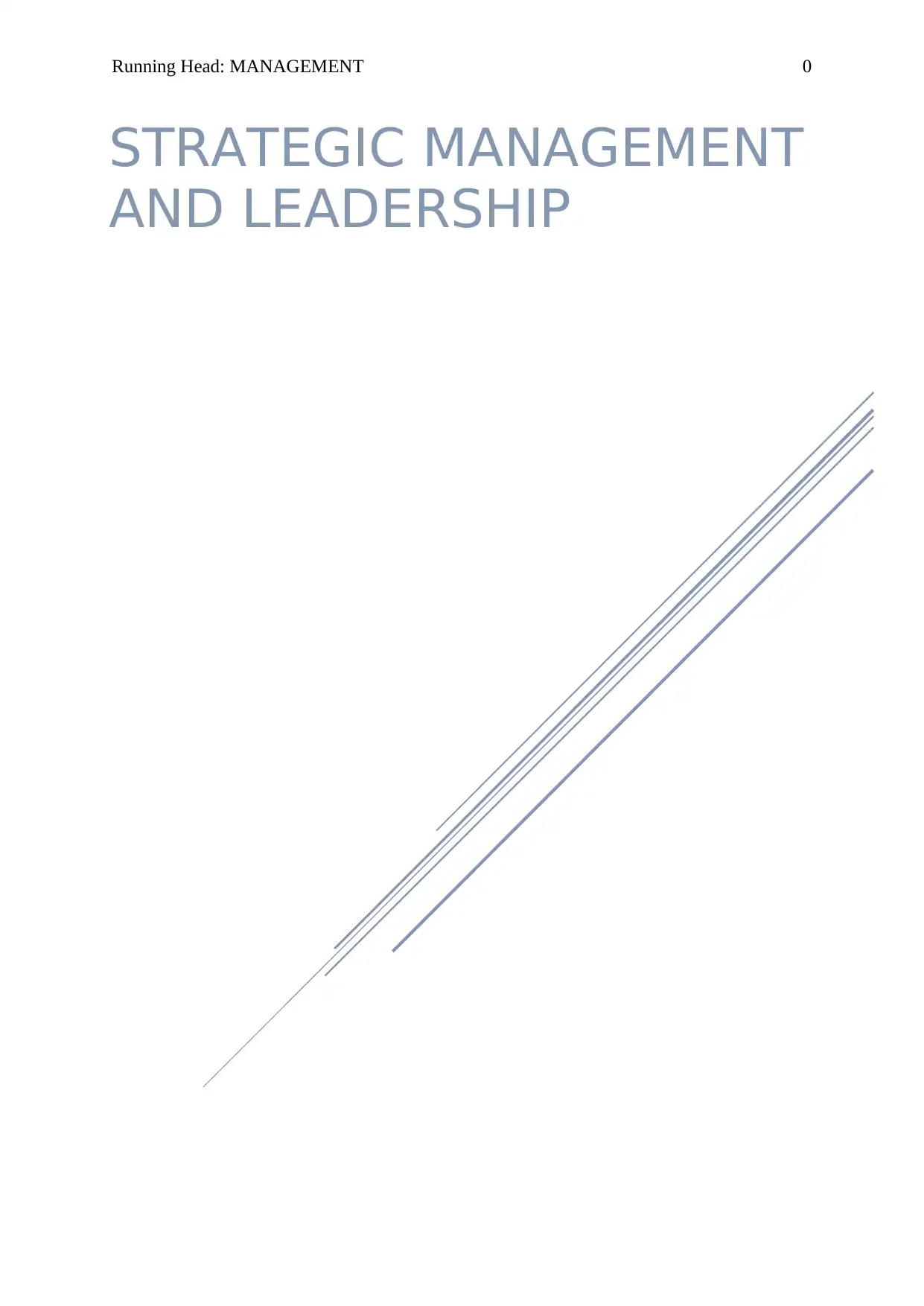
Running Head: MANAGEMENT 0
`
STRATEGIC MANAGEMENT
AND LEADERSHIP
`
STRATEGIC MANAGEMENT
AND LEADERSHIP
Paraphrase This Document
Need a fresh take? Get an instant paraphrase of this document with our AI Paraphraser
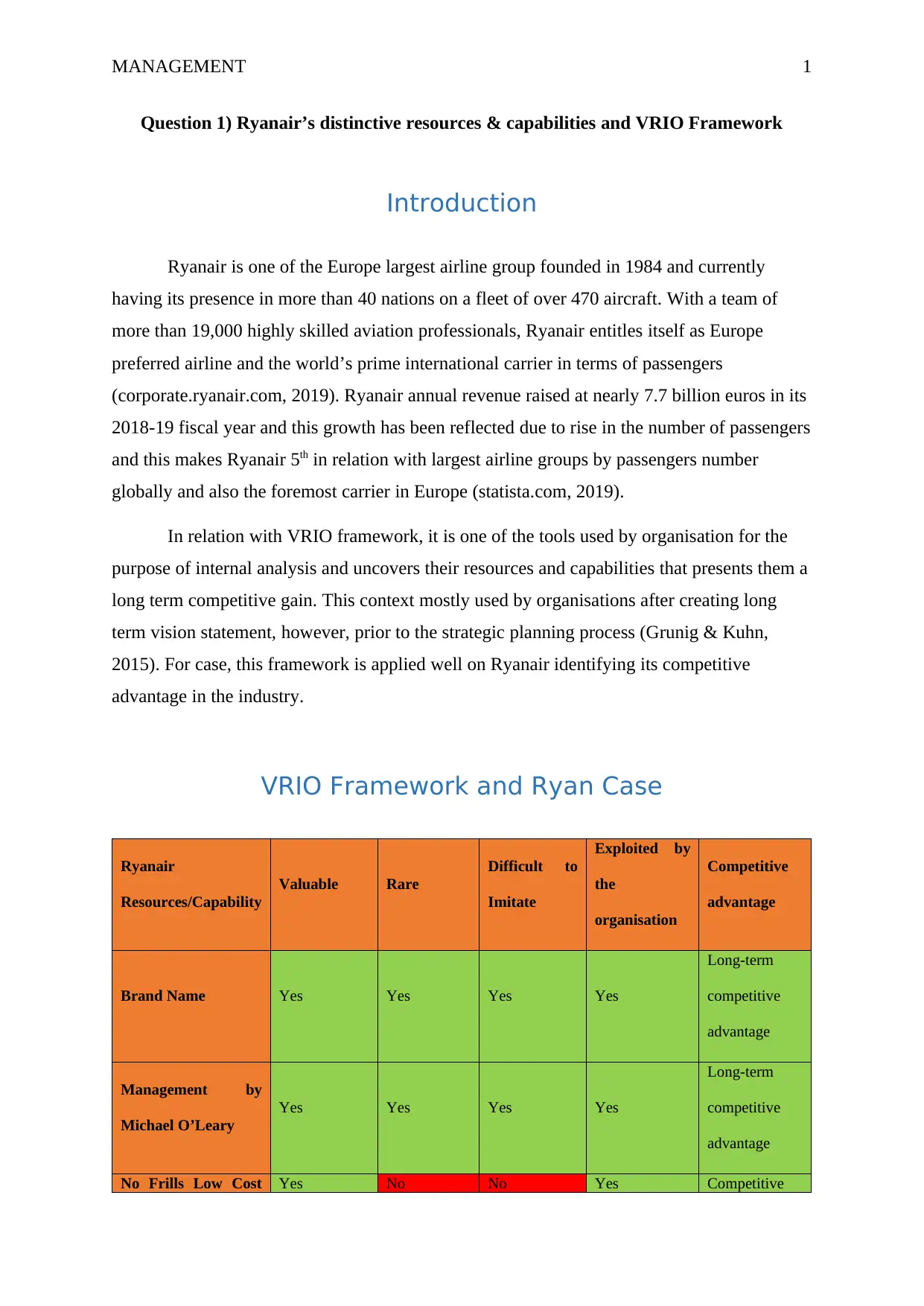
MANAGEMENT 1
Question 1) Ryanair’s distinctive resources & capabilities and VRIO Framework
Introduction
Ryanair is one of the Europe largest airline group founded in 1984 and currently
having its presence in more than 40 nations on a fleet of over 470 aircraft. With a team of
more than 19,000 highly skilled aviation professionals, Ryanair entitles itself as Europe
preferred airline and the world’s prime international carrier in terms of passengers
(corporate.ryanair.com, 2019). Ryanair annual revenue raised at nearly 7.7 billion euros in its
2018-19 fiscal year and this growth has been reflected due to rise in the number of passengers
and this makes Ryanair 5th in relation with largest airline groups by passengers number
globally and also the foremost carrier in Europe (statista.com, 2019).
In relation with VRIO framework, it is one of the tools used by organisation for the
purpose of internal analysis and uncovers their resources and capabilities that presents them a
long term competitive gain. This context mostly used by organisations after creating long
term vision statement, however, prior to the strategic planning process (Grunig & Kuhn,
2015). For case, this framework is applied well on Ryanair identifying its competitive
advantage in the industry.
VRIO Framework and Ryan Case
Ryanair
Resources/Capability
Valuable Rare
Difficult to
Imitate
Exploited by
the
organisation
Competitive
advantage
Brand Name Yes Yes Yes Yes
Long-term
competitive
advantage
Management by
Michael O’Leary
Yes Yes Yes Yes
Long-term
competitive
advantage
No Frills Low Cost Yes No No Yes Competitive
Question 1) Ryanair’s distinctive resources & capabilities and VRIO Framework
Introduction
Ryanair is one of the Europe largest airline group founded in 1984 and currently
having its presence in more than 40 nations on a fleet of over 470 aircraft. With a team of
more than 19,000 highly skilled aviation professionals, Ryanair entitles itself as Europe
preferred airline and the world’s prime international carrier in terms of passengers
(corporate.ryanair.com, 2019). Ryanair annual revenue raised at nearly 7.7 billion euros in its
2018-19 fiscal year and this growth has been reflected due to rise in the number of passengers
and this makes Ryanair 5th in relation with largest airline groups by passengers number
globally and also the foremost carrier in Europe (statista.com, 2019).
In relation with VRIO framework, it is one of the tools used by organisation for the
purpose of internal analysis and uncovers their resources and capabilities that presents them a
long term competitive gain. This context mostly used by organisations after creating long
term vision statement, however, prior to the strategic planning process (Grunig & Kuhn,
2015). For case, this framework is applied well on Ryanair identifying its competitive
advantage in the industry.
VRIO Framework and Ryan Case
Ryanair
Resources/Capability
Valuable Rare
Difficult to
Imitate
Exploited by
the
organisation
Competitive
advantage
Brand Name Yes Yes Yes Yes
Long-term
competitive
advantage
Management by
Michael O’Leary
Yes Yes Yes Yes
Long-term
competitive
advantage
No Frills Low Cost Yes No No Yes Competitive
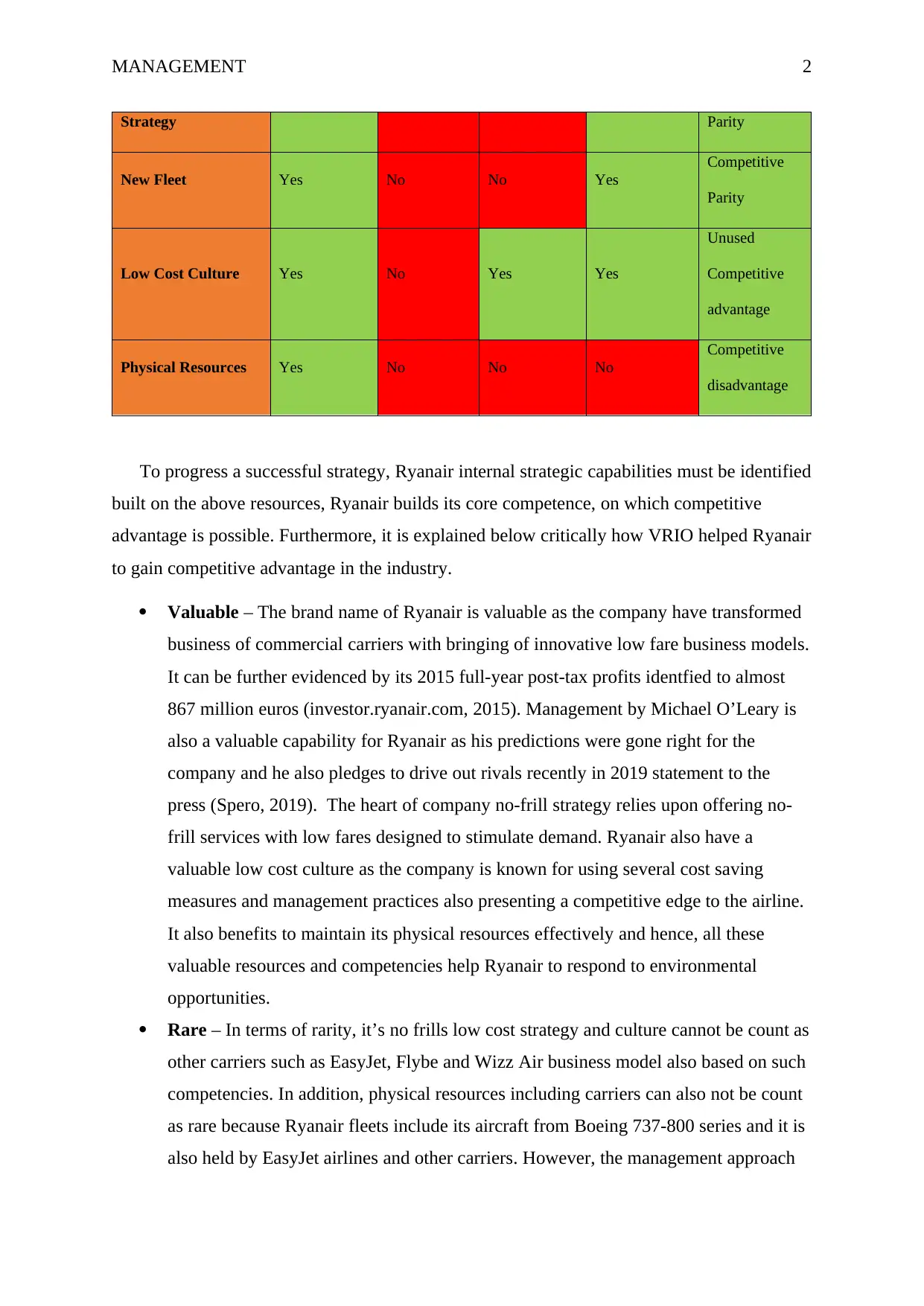
MANAGEMENT 2
Strategy Parity
New Fleet Yes No No Yes
Competitive
Parity
Low Cost Culture Yes No Yes Yes
Unused
Competitive
advantage
Physical Resources Yes No No No
Competitive
disadvantage
To progress a successful strategy, Ryanair internal strategic capabilities must be identified
built on the above resources, Ryanair builds its core competence, on which competitive
advantage is possible. Furthermore, it is explained below critically how VRIO helped Ryanair
to gain competitive advantage in the industry.
Valuable – The brand name of Ryanair is valuable as the company have transformed
business of commercial carriers with bringing of innovative low fare business models.
It can be further evidenced by its 2015 full-year post-tax profits identfied to almost
867 million euros (investor.ryanair.com, 2015). Management by Michael O’Leary is
also a valuable capability for Ryanair as his predictions were gone right for the
company and he also pledges to drive out rivals recently in 2019 statement to the
press (Spero, 2019). The heart of company no-frill strategy relies upon offering no-
frill services with low fares designed to stimulate demand. Ryanair also have a
valuable low cost culture as the company is known for using several cost saving
measures and management practices also presenting a competitive edge to the airline.
It also benefits to maintain its physical resources effectively and hence, all these
valuable resources and competencies help Ryanair to respond to environmental
opportunities.
Rare – In terms of rarity, it’s no frills low cost strategy and culture cannot be count as
other carriers such as EasyJet, Flybe and Wizz Air business model also based on such
competencies. In addition, physical resources including carriers can also not be count
as rare because Ryanair fleets include its aircraft from Boeing 737-800 series and it is
also held by EasyJet airlines and other carriers. However, the management approach
Strategy Parity
New Fleet Yes No No Yes
Competitive
Parity
Low Cost Culture Yes No Yes Yes
Unused
Competitive
advantage
Physical Resources Yes No No No
Competitive
disadvantage
To progress a successful strategy, Ryanair internal strategic capabilities must be identified
built on the above resources, Ryanair builds its core competence, on which competitive
advantage is possible. Furthermore, it is explained below critically how VRIO helped Ryanair
to gain competitive advantage in the industry.
Valuable – The brand name of Ryanair is valuable as the company have transformed
business of commercial carriers with bringing of innovative low fare business models.
It can be further evidenced by its 2015 full-year post-tax profits identfied to almost
867 million euros (investor.ryanair.com, 2015). Management by Michael O’Leary is
also a valuable capability for Ryanair as his predictions were gone right for the
company and he also pledges to drive out rivals recently in 2019 statement to the
press (Spero, 2019). The heart of company no-frill strategy relies upon offering no-
frill services with low fares designed to stimulate demand. Ryanair also have a
valuable low cost culture as the company is known for using several cost saving
measures and management practices also presenting a competitive edge to the airline.
It also benefits to maintain its physical resources effectively and hence, all these
valuable resources and competencies help Ryanair to respond to environmental
opportunities.
Rare – In terms of rarity, it’s no frills low cost strategy and culture cannot be count as
other carriers such as EasyJet, Flybe and Wizz Air business model also based on such
competencies. In addition, physical resources including carriers can also not be count
as rare because Ryanair fleets include its aircraft from Boeing 737-800 series and it is
also held by EasyJet airlines and other carriers. However, the management approach
⊘ This is a preview!⊘
Do you want full access?
Subscribe today to unlock all pages.

Trusted by 1+ million students worldwide
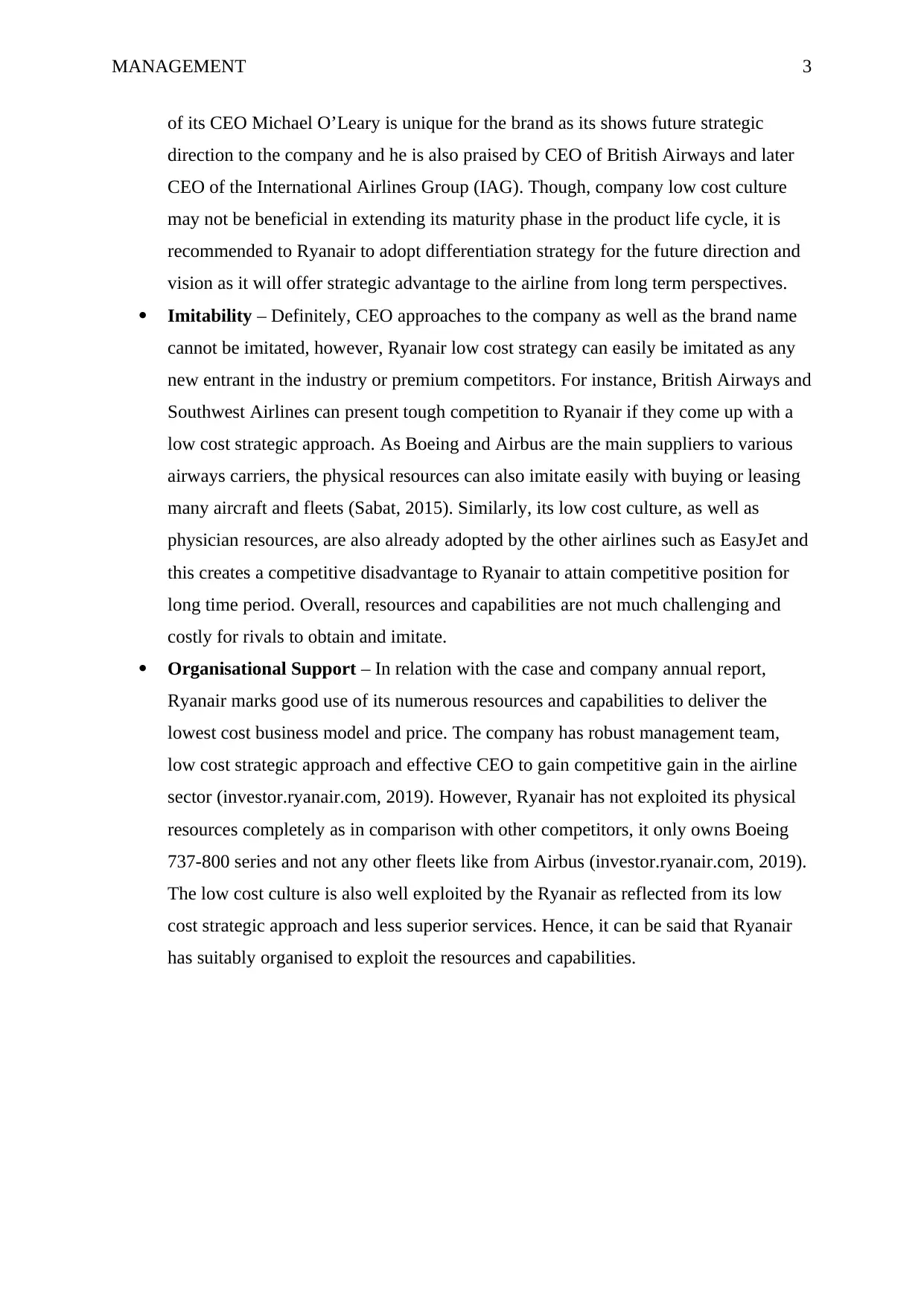
MANAGEMENT 3
of its CEO Michael O’Leary is unique for the brand as its shows future strategic
direction to the company and he is also praised by CEO of British Airways and later
CEO of the International Airlines Group (IAG). Though, company low cost culture
may not be beneficial in extending its maturity phase in the product life cycle, it is
recommended to Ryanair to adopt differentiation strategy for the future direction and
vision as it will offer strategic advantage to the airline from long term perspectives.
Imitability – Definitely, CEO approaches to the company as well as the brand name
cannot be imitated, however, Ryanair low cost strategy can easily be imitated as any
new entrant in the industry or premium competitors. For instance, British Airways and
Southwest Airlines can present tough competition to Ryanair if they come up with a
low cost strategic approach. As Boeing and Airbus are the main suppliers to various
airways carriers, the physical resources can also imitate easily with buying or leasing
many aircraft and fleets (Sabat, 2015). Similarly, its low cost culture, as well as
physician resources, are also already adopted by the other airlines such as EasyJet and
this creates a competitive disadvantage to Ryanair to attain competitive position for
long time period. Overall, resources and capabilities are not much challenging and
costly for rivals to obtain and imitate.
Organisational Support – In relation with the case and company annual report,
Ryanair marks good use of its numerous resources and capabilities to deliver the
lowest cost business model and price. The company has robust management team,
low cost strategic approach and effective CEO to gain competitive gain in the airline
sector (investor.ryanair.com, 2019). However, Ryanair has not exploited its physical
resources completely as in comparison with other competitors, it only owns Boeing
737-800 series and not any other fleets like from Airbus (investor.ryanair.com, 2019).
The low cost culture is also well exploited by the Ryanair as reflected from its low
cost strategic approach and less superior services. Hence, it can be said that Ryanair
has suitably organised to exploit the resources and capabilities.
of its CEO Michael O’Leary is unique for the brand as its shows future strategic
direction to the company and he is also praised by CEO of British Airways and later
CEO of the International Airlines Group (IAG). Though, company low cost culture
may not be beneficial in extending its maturity phase in the product life cycle, it is
recommended to Ryanair to adopt differentiation strategy for the future direction and
vision as it will offer strategic advantage to the airline from long term perspectives.
Imitability – Definitely, CEO approaches to the company as well as the brand name
cannot be imitated, however, Ryanair low cost strategy can easily be imitated as any
new entrant in the industry or premium competitors. For instance, British Airways and
Southwest Airlines can present tough competition to Ryanair if they come up with a
low cost strategic approach. As Boeing and Airbus are the main suppliers to various
airways carriers, the physical resources can also imitate easily with buying or leasing
many aircraft and fleets (Sabat, 2015). Similarly, its low cost culture, as well as
physician resources, are also already adopted by the other airlines such as EasyJet and
this creates a competitive disadvantage to Ryanair to attain competitive position for
long time period. Overall, resources and capabilities are not much challenging and
costly for rivals to obtain and imitate.
Organisational Support – In relation with the case and company annual report,
Ryanair marks good use of its numerous resources and capabilities to deliver the
lowest cost business model and price. The company has robust management team,
low cost strategic approach and effective CEO to gain competitive gain in the airline
sector (investor.ryanair.com, 2019). However, Ryanair has not exploited its physical
resources completely as in comparison with other competitors, it only owns Boeing
737-800 series and not any other fleets like from Airbus (investor.ryanair.com, 2019).
The low cost culture is also well exploited by the Ryanair as reflected from its low
cost strategic approach and less superior services. Hence, it can be said that Ryanair
has suitably organised to exploit the resources and capabilities.
Paraphrase This Document
Need a fresh take? Get an instant paraphrase of this document with our AI Paraphraser
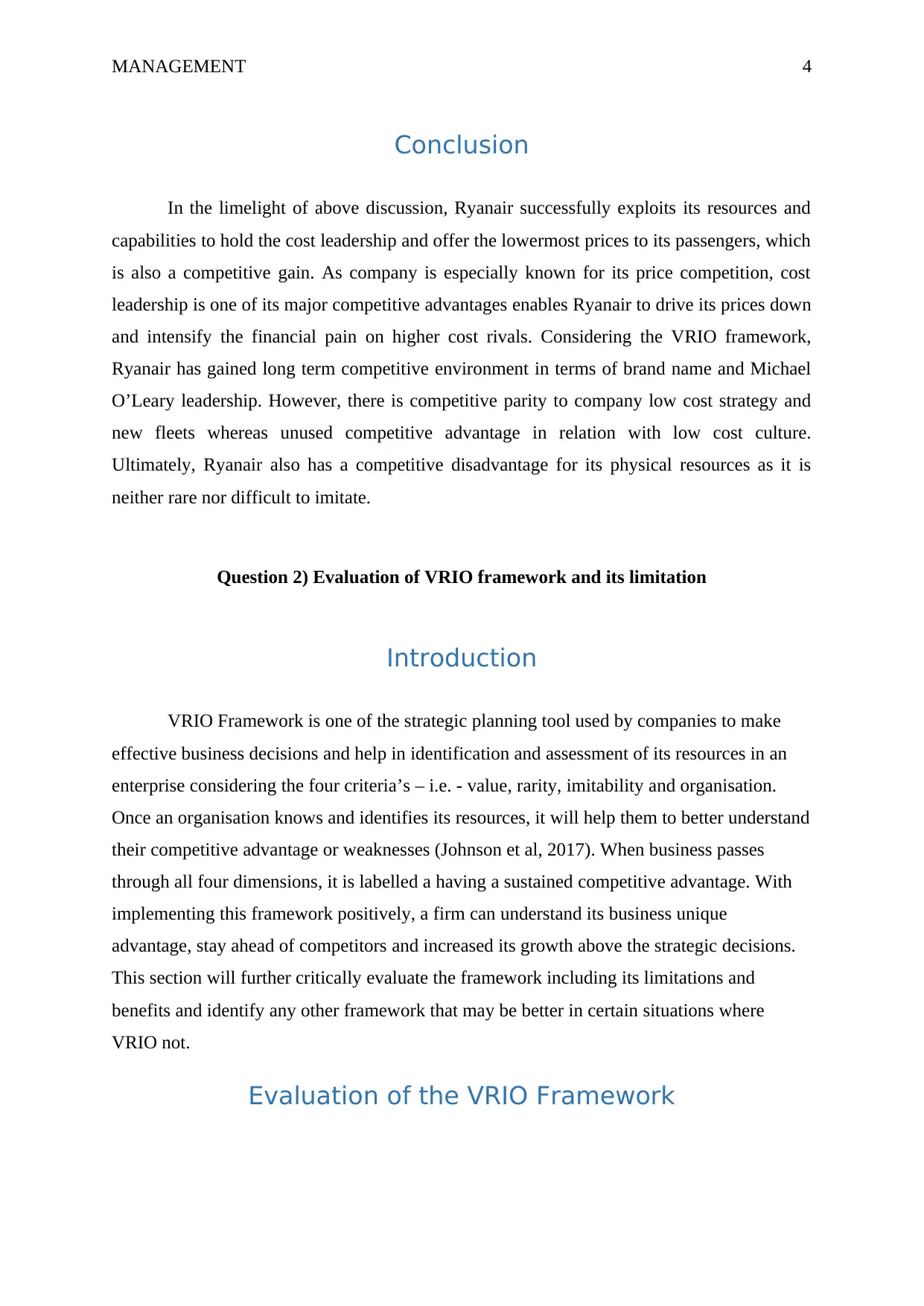
MANAGEMENT 4
Conclusion
In the limelight of above discussion, Ryanair successfully exploits its resources and
capabilities to hold the cost leadership and offer the lowermost prices to its passengers, which
is also a competitive gain. As company is especially known for its price competition, cost
leadership is one of its major competitive advantages enables Ryanair to drive its prices down
and intensify the financial pain on higher cost rivals. Considering the VRIO framework,
Ryanair has gained long term competitive environment in terms of brand name and Michael
O’Leary leadership. However, there is competitive parity to company low cost strategy and
new fleets whereas unused competitive advantage in relation with low cost culture.
Ultimately, Ryanair also has a competitive disadvantage for its physical resources as it is
neither rare nor difficult to imitate.
Question 2) Evaluation of VRIO framework and its limitation
Introduction
VRIO Framework is one of the strategic planning tool used by companies to make
effective business decisions and help in identification and assessment of its resources in an
enterprise considering the four criteria’s – i.e. - value, rarity, imitability and organisation.
Once an organisation knows and identifies its resources, it will help them to better understand
their competitive advantage or weaknesses (Johnson et al, 2017). When business passes
through all four dimensions, it is labelled a having a sustained competitive advantage. With
implementing this framework positively, a firm can understand its business unique
advantage, stay ahead of competitors and increased its growth above the strategic decisions.
This section will further critically evaluate the framework including its limitations and
benefits and identify any other framework that may be better in certain situations where
VRIO not.
Evaluation of the VRIO Framework
Conclusion
In the limelight of above discussion, Ryanair successfully exploits its resources and
capabilities to hold the cost leadership and offer the lowermost prices to its passengers, which
is also a competitive gain. As company is especially known for its price competition, cost
leadership is one of its major competitive advantages enables Ryanair to drive its prices down
and intensify the financial pain on higher cost rivals. Considering the VRIO framework,
Ryanair has gained long term competitive environment in terms of brand name and Michael
O’Leary leadership. However, there is competitive parity to company low cost strategy and
new fleets whereas unused competitive advantage in relation with low cost culture.
Ultimately, Ryanair also has a competitive disadvantage for its physical resources as it is
neither rare nor difficult to imitate.
Question 2) Evaluation of VRIO framework and its limitation
Introduction
VRIO Framework is one of the strategic planning tool used by companies to make
effective business decisions and help in identification and assessment of its resources in an
enterprise considering the four criteria’s – i.e. - value, rarity, imitability and organisation.
Once an organisation knows and identifies its resources, it will help them to better understand
their competitive advantage or weaknesses (Johnson et al, 2017). When business passes
through all four dimensions, it is labelled a having a sustained competitive advantage. With
implementing this framework positively, a firm can understand its business unique
advantage, stay ahead of competitors and increased its growth above the strategic decisions.
This section will further critically evaluate the framework including its limitations and
benefits and identify any other framework that may be better in certain situations where
VRIO not.
Evaluation of the VRIO Framework
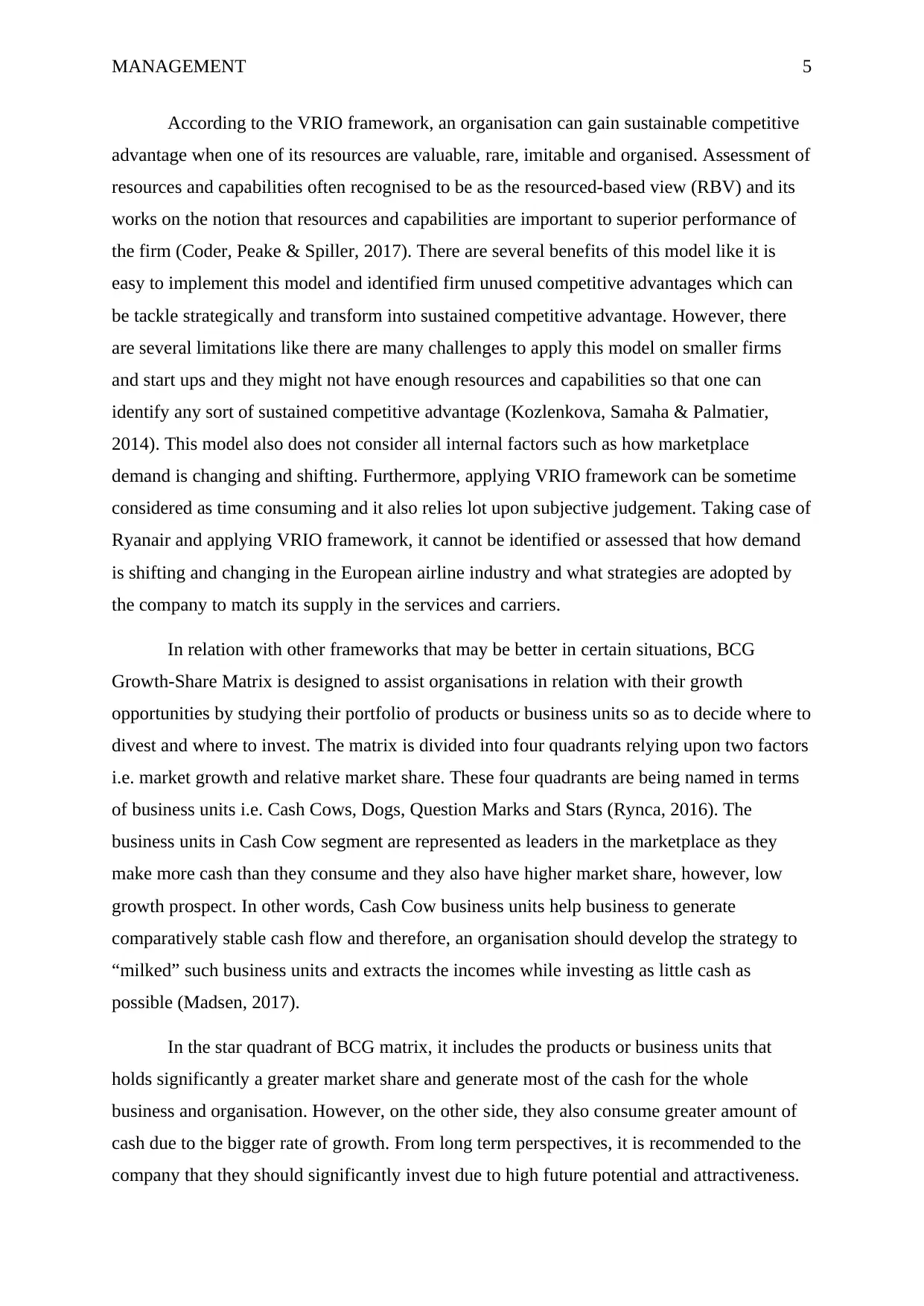
MANAGEMENT 5
According to the VRIO framework, an organisation can gain sustainable competitive
advantage when one of its resources are valuable, rare, imitable and organised. Assessment of
resources and capabilities often recognised to be as the resourced-based view (RBV) and its
works on the notion that resources and capabilities are important to superior performance of
the firm (Coder, Peake & Spiller, 2017). There are several benefits of this model like it is
easy to implement this model and identified firm unused competitive advantages which can
be tackle strategically and transform into sustained competitive advantage. However, there
are several limitations like there are many challenges to apply this model on smaller firms
and start ups and they might not have enough resources and capabilities so that one can
identify any sort of sustained competitive advantage (Kozlenkova, Samaha & Palmatier,
2014). This model also does not consider all internal factors such as how marketplace
demand is changing and shifting. Furthermore, applying VRIO framework can be sometime
considered as time consuming and it also relies lot upon subjective judgement. Taking case of
Ryanair and applying VRIO framework, it cannot be identified or assessed that how demand
is shifting and changing in the European airline industry and what strategies are adopted by
the company to match its supply in the services and carriers.
In relation with other frameworks that may be better in certain situations, BCG
Growth-Share Matrix is designed to assist organisations in relation with their growth
opportunities by studying their portfolio of products or business units so as to decide where to
divest and where to invest. The matrix is divided into four quadrants relying upon two factors
i.e. market growth and relative market share. These four quadrants are being named in terms
of business units i.e. Cash Cows, Dogs, Question Marks and Stars (Rynca, 2016). The
business units in Cash Cow segment are represented as leaders in the marketplace as they
make more cash than they consume and they also have higher market share, however, low
growth prospect. In other words, Cash Cow business units help business to generate
comparatively stable cash flow and therefore, an organisation should develop the strategy to
“milked” such business units and extracts the incomes while investing as little cash as
possible (Madsen, 2017).
In the star quadrant of BCG matrix, it includes the products or business units that
holds significantly a greater market share and generate most of the cash for the whole
business and organisation. However, on the other side, they also consume greater amount of
cash due to the bigger rate of growth. From long term perspectives, it is recommended to the
company that they should significantly invest due to high future potential and attractiveness.
According to the VRIO framework, an organisation can gain sustainable competitive
advantage when one of its resources are valuable, rare, imitable and organised. Assessment of
resources and capabilities often recognised to be as the resourced-based view (RBV) and its
works on the notion that resources and capabilities are important to superior performance of
the firm (Coder, Peake & Spiller, 2017). There are several benefits of this model like it is
easy to implement this model and identified firm unused competitive advantages which can
be tackle strategically and transform into sustained competitive advantage. However, there
are several limitations like there are many challenges to apply this model on smaller firms
and start ups and they might not have enough resources and capabilities so that one can
identify any sort of sustained competitive advantage (Kozlenkova, Samaha & Palmatier,
2014). This model also does not consider all internal factors such as how marketplace
demand is changing and shifting. Furthermore, applying VRIO framework can be sometime
considered as time consuming and it also relies lot upon subjective judgement. Taking case of
Ryanair and applying VRIO framework, it cannot be identified or assessed that how demand
is shifting and changing in the European airline industry and what strategies are adopted by
the company to match its supply in the services and carriers.
In relation with other frameworks that may be better in certain situations, BCG
Growth-Share Matrix is designed to assist organisations in relation with their growth
opportunities by studying their portfolio of products or business units so as to decide where to
divest and where to invest. The matrix is divided into four quadrants relying upon two factors
i.e. market growth and relative market share. These four quadrants are being named in terms
of business units i.e. Cash Cows, Dogs, Question Marks and Stars (Rynca, 2016). The
business units in Cash Cow segment are represented as leaders in the marketplace as they
make more cash than they consume and they also have higher market share, however, low
growth prospect. In other words, Cash Cow business units help business to generate
comparatively stable cash flow and therefore, an organisation should develop the strategy to
“milked” such business units and extracts the incomes while investing as little cash as
possible (Madsen, 2017).
In the star quadrant of BCG matrix, it includes the products or business units that
holds significantly a greater market share and generate most of the cash for the whole
business and organisation. However, on the other side, they also consume greater amount of
cash due to the bigger rate of growth. From long term perspectives, it is recommended to the
company that they should significantly invest due to high future potential and attractiveness.
⊘ This is a preview!⊘
Do you want full access?
Subscribe today to unlock all pages.

Trusted by 1+ million students worldwide
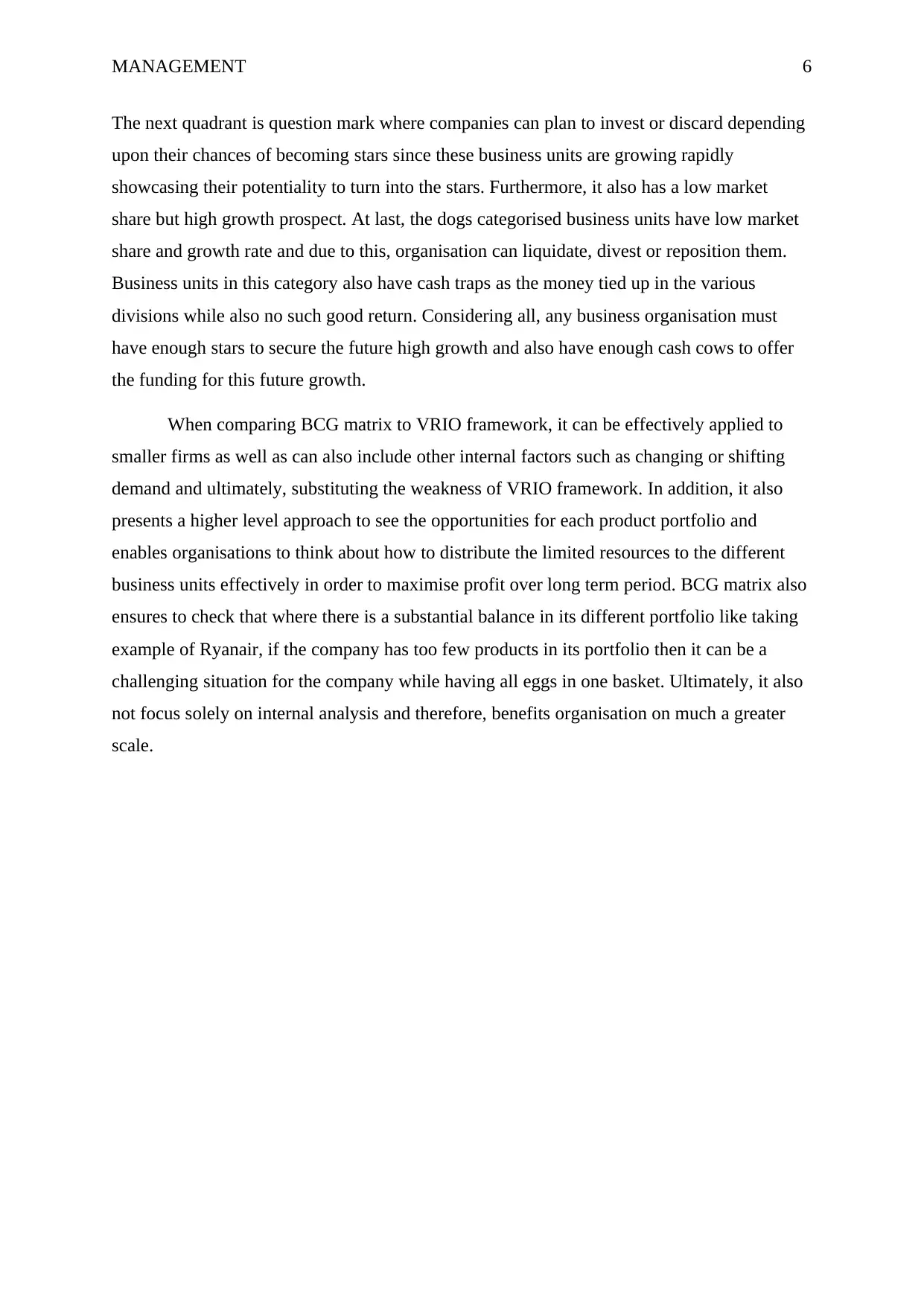
MANAGEMENT 6
The next quadrant is question mark where companies can plan to invest or discard depending
upon their chances of becoming stars since these business units are growing rapidly
showcasing their potentiality to turn into the stars. Furthermore, it also has a low market
share but high growth prospect. At last, the dogs categorised business units have low market
share and growth rate and due to this, organisation can liquidate, divest or reposition them.
Business units in this category also have cash traps as the money tied up in the various
divisions while also no such good return. Considering all, any business organisation must
have enough stars to secure the future high growth and also have enough cash cows to offer
the funding for this future growth.
When comparing BCG matrix to VRIO framework, it can be effectively applied to
smaller firms as well as can also include other internal factors such as changing or shifting
demand and ultimately, substituting the weakness of VRIO framework. In addition, it also
presents a higher level approach to see the opportunities for each product portfolio and
enables organisations to think about how to distribute the limited resources to the different
business units effectively in order to maximise profit over long term period. BCG matrix also
ensures to check that where there is a substantial balance in its different portfolio like taking
example of Ryanair, if the company has too few products in its portfolio then it can be a
challenging situation for the company while having all eggs in one basket. Ultimately, it also
not focus solely on internal analysis and therefore, benefits organisation on much a greater
scale.
The next quadrant is question mark where companies can plan to invest or discard depending
upon their chances of becoming stars since these business units are growing rapidly
showcasing their potentiality to turn into the stars. Furthermore, it also has a low market
share but high growth prospect. At last, the dogs categorised business units have low market
share and growth rate and due to this, organisation can liquidate, divest or reposition them.
Business units in this category also have cash traps as the money tied up in the various
divisions while also no such good return. Considering all, any business organisation must
have enough stars to secure the future high growth and also have enough cash cows to offer
the funding for this future growth.
When comparing BCG matrix to VRIO framework, it can be effectively applied to
smaller firms as well as can also include other internal factors such as changing or shifting
demand and ultimately, substituting the weakness of VRIO framework. In addition, it also
presents a higher level approach to see the opportunities for each product portfolio and
enables organisations to think about how to distribute the limited resources to the different
business units effectively in order to maximise profit over long term period. BCG matrix also
ensures to check that where there is a substantial balance in its different portfolio like taking
example of Ryanair, if the company has too few products in its portfolio then it can be a
challenging situation for the company while having all eggs in one basket. Ultimately, it also
not focus solely on internal analysis and therefore, benefits organisation on much a greater
scale.
Paraphrase This Document
Need a fresh take? Get an instant paraphrase of this document with our AI Paraphraser
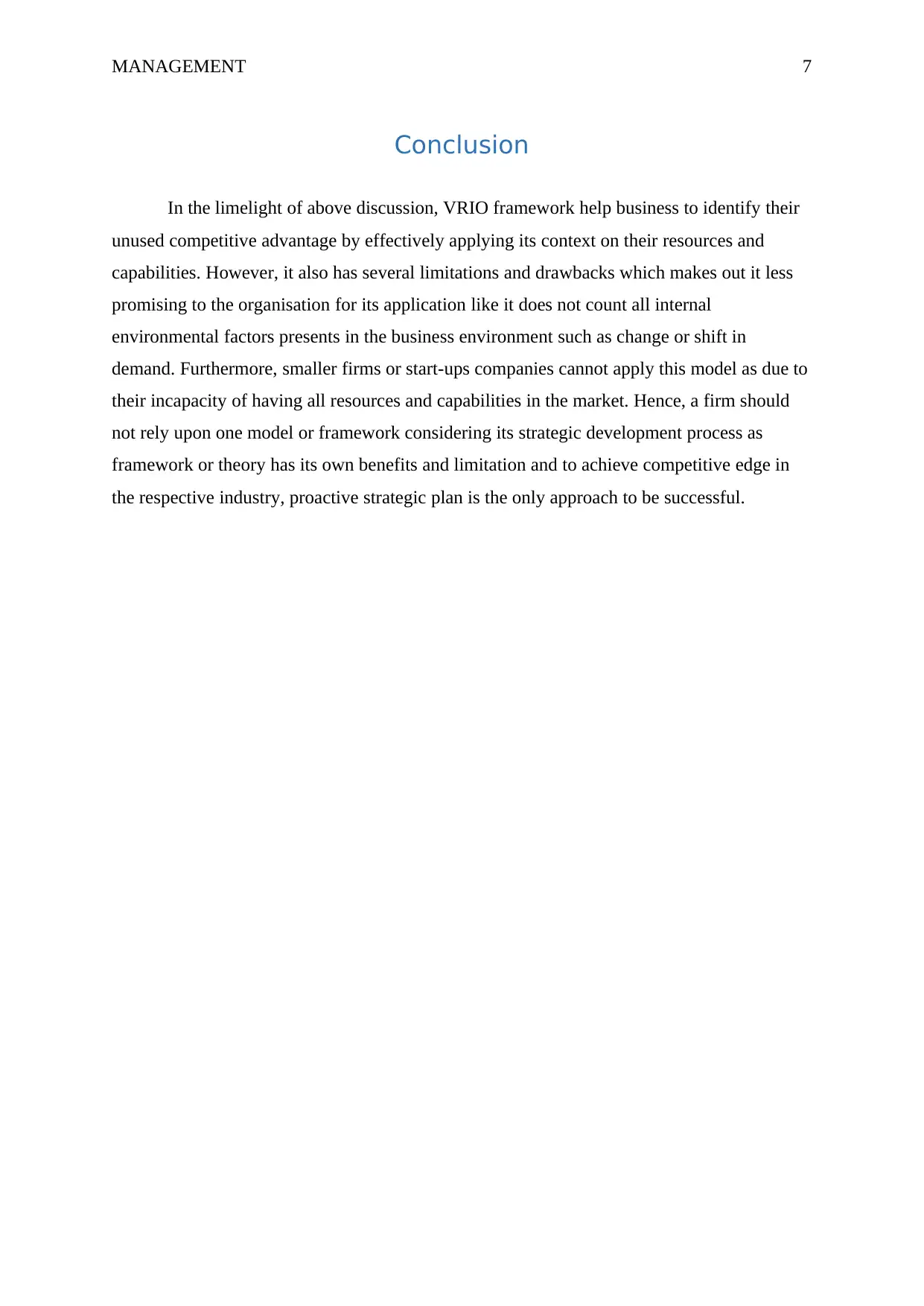
MANAGEMENT 7
Conclusion
In the limelight of above discussion, VRIO framework help business to identify their
unused competitive advantage by effectively applying its context on their resources and
capabilities. However, it also has several limitations and drawbacks which makes out it less
promising to the organisation for its application like it does not count all internal
environmental factors presents in the business environment such as change or shift in
demand. Furthermore, smaller firms or start-ups companies cannot apply this model as due to
their incapacity of having all resources and capabilities in the market. Hence, a firm should
not rely upon one model or framework considering its strategic development process as
framework or theory has its own benefits and limitation and to achieve competitive edge in
the respective industry, proactive strategic plan is the only approach to be successful.
Conclusion
In the limelight of above discussion, VRIO framework help business to identify their
unused competitive advantage by effectively applying its context on their resources and
capabilities. However, it also has several limitations and drawbacks which makes out it less
promising to the organisation for its application like it does not count all internal
environmental factors presents in the business environment such as change or shift in
demand. Furthermore, smaller firms or start-ups companies cannot apply this model as due to
their incapacity of having all resources and capabilities in the market. Hence, a firm should
not rely upon one model or framework considering its strategic development process as
framework or theory has its own benefits and limitation and to achieve competitive edge in
the respective industry, proactive strategic plan is the only approach to be successful.
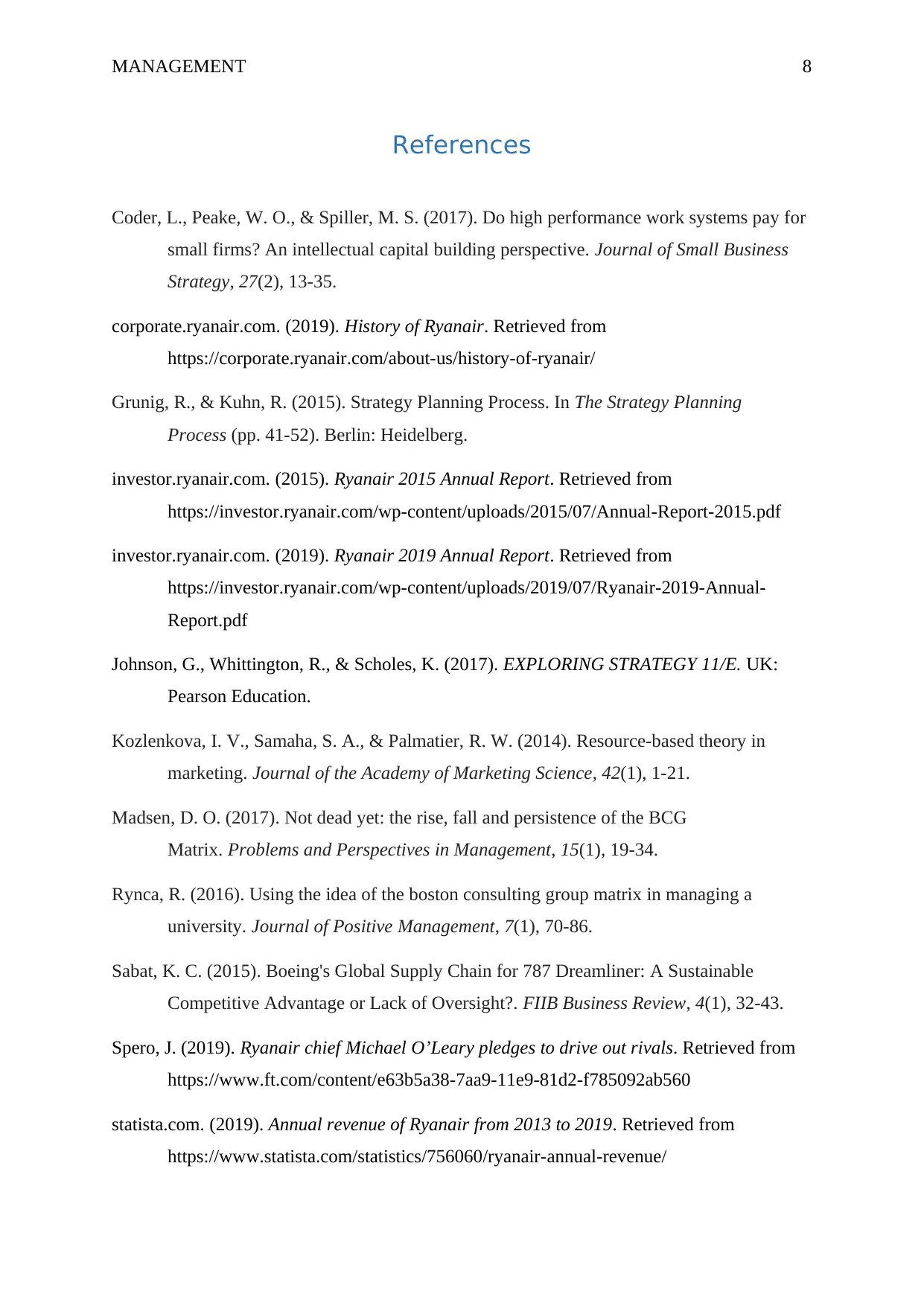
MANAGEMENT 8
References
Coder, L., Peake, W. O., & Spiller, M. S. (2017). Do high performance work systems pay for
small firms? An intellectual capital building perspective. Journal of Small Business
Strategy, 27(2), 13-35.
corporate.ryanair.com. (2019). History of Ryanair. Retrieved from
https://corporate.ryanair.com/about-us/history-of-ryanair/
Grunig, R., & Kuhn, R. (2015). Strategy Planning Process. In The Strategy Planning
Process (pp. 41-52). Berlin: Heidelberg.
investor.ryanair.com. (2015). Ryanair 2015 Annual Report. Retrieved from
https://investor.ryanair.com/wp-content/uploads/2015/07/Annual-Report-2015.pdf
investor.ryanair.com. (2019). Ryanair 2019 Annual Report. Retrieved from
https://investor.ryanair.com/wp-content/uploads/2019/07/Ryanair-2019-Annual-
Report.pdf
Johnson, G., Whittington, R., & Scholes, K. (2017). EXPLORING STRATEGY 11/E. UK:
Pearson Education.
Kozlenkova, I. V., Samaha, S. A., & Palmatier, R. W. (2014). Resource-based theory in
marketing. Journal of the Academy of Marketing Science, 42(1), 1-21.
Madsen, D. O. (2017). Not dead yet: the rise, fall and persistence of the BCG
Matrix. Problems and Perspectives in Management, 15(1), 19-34.
Rynca, R. (2016). Using the idea of the boston consulting group matrix in managing a
university. Journal of Positive Management, 7(1), 70-86.
Sabat, K. C. (2015). Boeing's Global Supply Chain for 787 Dreamliner: A Sustainable
Competitive Advantage or Lack of Oversight?. FIIB Business Review, 4(1), 32-43.
Spero, J. (2019). Ryanair chief Michael O’Leary pledges to drive out rivals. Retrieved from
https://www.ft.com/content/e63b5a38-7aa9-11e9-81d2-f785092ab560
statista.com. (2019). Annual revenue of Ryanair from 2013 to 2019. Retrieved from
https://www.statista.com/statistics/756060/ryanair-annual-revenue/
References
Coder, L., Peake, W. O., & Spiller, M. S. (2017). Do high performance work systems pay for
small firms? An intellectual capital building perspective. Journal of Small Business
Strategy, 27(2), 13-35.
corporate.ryanair.com. (2019). History of Ryanair. Retrieved from
https://corporate.ryanair.com/about-us/history-of-ryanair/
Grunig, R., & Kuhn, R. (2015). Strategy Planning Process. In The Strategy Planning
Process (pp. 41-52). Berlin: Heidelberg.
investor.ryanair.com. (2015). Ryanair 2015 Annual Report. Retrieved from
https://investor.ryanair.com/wp-content/uploads/2015/07/Annual-Report-2015.pdf
investor.ryanair.com. (2019). Ryanair 2019 Annual Report. Retrieved from
https://investor.ryanair.com/wp-content/uploads/2019/07/Ryanair-2019-Annual-
Report.pdf
Johnson, G., Whittington, R., & Scholes, K. (2017). EXPLORING STRATEGY 11/E. UK:
Pearson Education.
Kozlenkova, I. V., Samaha, S. A., & Palmatier, R. W. (2014). Resource-based theory in
marketing. Journal of the Academy of Marketing Science, 42(1), 1-21.
Madsen, D. O. (2017). Not dead yet: the rise, fall and persistence of the BCG
Matrix. Problems and Perspectives in Management, 15(1), 19-34.
Rynca, R. (2016). Using the idea of the boston consulting group matrix in managing a
university. Journal of Positive Management, 7(1), 70-86.
Sabat, K. C. (2015). Boeing's Global Supply Chain for 787 Dreamliner: A Sustainable
Competitive Advantage or Lack of Oversight?. FIIB Business Review, 4(1), 32-43.
Spero, J. (2019). Ryanair chief Michael O’Leary pledges to drive out rivals. Retrieved from
https://www.ft.com/content/e63b5a38-7aa9-11e9-81d2-f785092ab560
statista.com. (2019). Annual revenue of Ryanair from 2013 to 2019. Retrieved from
https://www.statista.com/statistics/756060/ryanair-annual-revenue/
⊘ This is a preview!⊘
Do you want full access?
Subscribe today to unlock all pages.

Trusted by 1+ million students worldwide
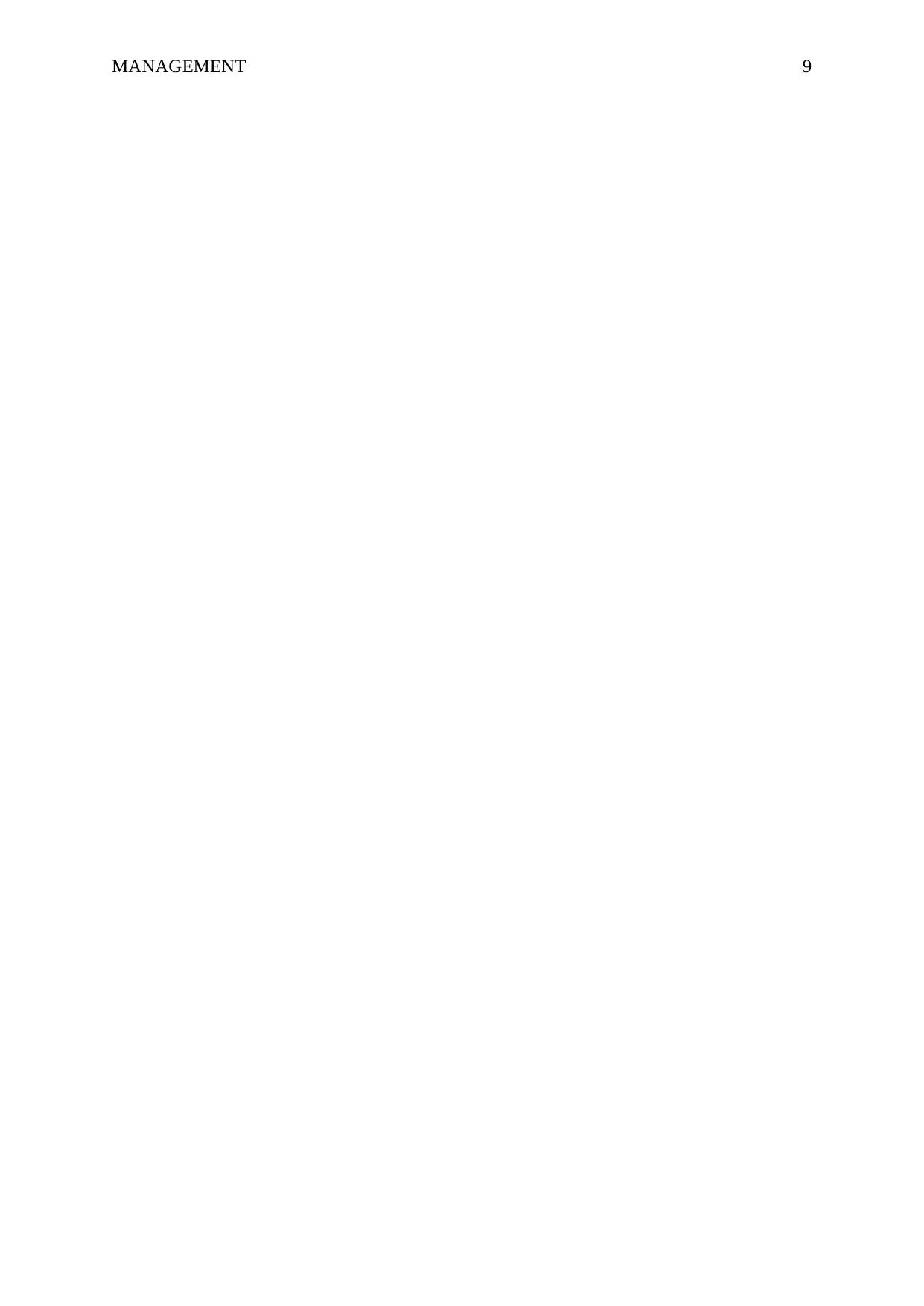
MANAGEMENT 9
1 out of 10
Related Documents
Your All-in-One AI-Powered Toolkit for Academic Success.
+13062052269
info@desklib.com
Available 24*7 on WhatsApp / Email
![[object Object]](/_next/static/media/star-bottom.7253800d.svg)
Unlock your academic potential
Copyright © 2020–2025 A2Z Services. All Rights Reserved. Developed and managed by ZUCOL.





